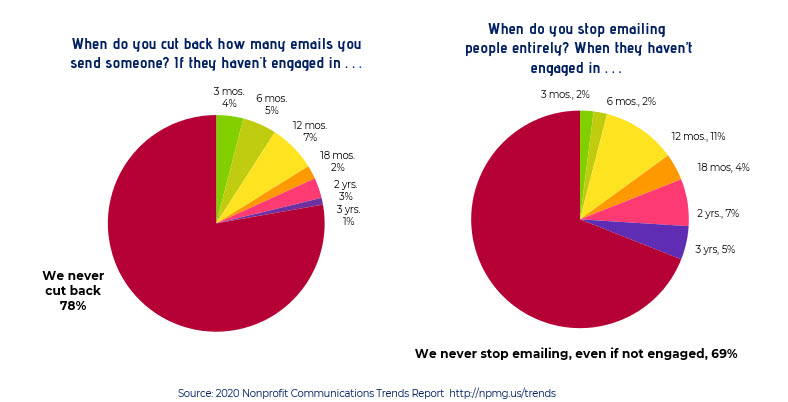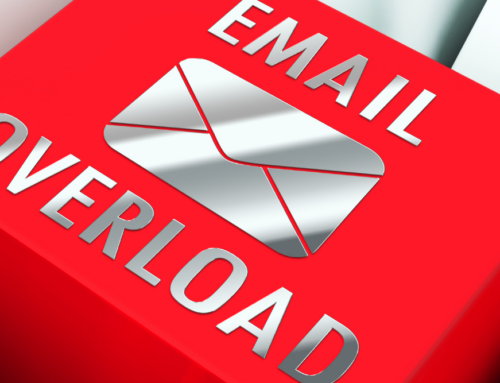For the last several years, we’ve blogged and trained nonprofit communicators about the importance of monitoring email engagement – not just open and click-through rates on individual emails, but how many people on your email list have opened at least one email within a set period time, such as the last three months.
It’s not a number that’s front and center in most email service provider dashboards (but should be). Yet it’s incredibly important to whether your emails get delivered to the inbox or to the spam folder.
For this year’s Nonprofit Communications Trends Report, we decided to survey the extent to which nonprofits are implementing good email list management practices. The results are not good. In fact, they are downright awful.
We at Nonprofit Marketing Guide aren’t “the sky is falling” alarmist types by nature. But we’re pulling the alarm on this one: If nonprofits don’t start implementing email list management and engagement best practices, they will bring on their own personal email apocalypse.
Nonprofits that ignore email engagement and list management best practices will soon find that what used to be an effective communications tool has become utterly unreliable and perhaps even useless.
Why? Because if you don’t manage your email marketing for engagement, your deliverability will go down. That’s the email jargon for “your emails will go straight to the spam folder.” It’s time to stop worrying so much about whether your subject line sounds spammy and start worrying about how you manage your mailing list.
We aren’t the only ones sounding the alarm. EveryAction’s 2019 Email Deliverability Study estimates that the nonprofit sector could be losing almost $100 million in donations because appeals are going into spam folders.
In its 2019 end-of-year fundraising season wrap-up, M+R reported that email deliverability was a big problem, with many nonprofits struggling to get their email appeals into inboxes. In their 2018 year-end analysis, they found that nonprofits who saw their list size drop year-over-year (because they actively managed their lists, dropping the unengaged) also saw better returns: a 26% improvement in response rate and a 2% improvement in email revenue.
Email deliverability and engagement are like the climate change of nonprofit communications. Half of the people are unaware or in denial about it and the other half aren’t sure what to do or if their actions will make a difference.
Kivi Leroux Miller, Nonprofit Marketing Guide
Learn how to avoid the apocalypse during my a brand new webinar series Email Marketing Trends for Nonprofits
It’s time (actually it’s past time, right now, in early 2020) to evaluate where you are and what you need to do.
If you are already experiencing problems, you can repair the damage. But it takes a lot of time, energy and work to do so (more than managing for engagement in the first place) . . . and the results aren’t guaranteed. And for anyone thinking that just switching to another email provider will solve your problems: think again. The heart of the problem is your list and how you manage it. Transferring bad habits to a new email provider won’t work.
Nonprofits Largely Ignoring Email List Management Best Practices
A basic tenet of email engagement and deliverability is to only mail people who demonstrate that they want your content by continuing to open it.
It doesn’t take much to be considered “engaged.” While there isn’t a hard and fast rule at this time, most email service providers consider a subscriber engaged if they have opened at least one email in the last 3-6 months.
When a subscriber has stopped opening emails after a designated amount of time, you should send them a re-engagement series of emails to try to get them to open an email again. If they still don’t open an email, you should stop emailing them (or at a minimum, limit the number of emails you send in the future.)
We found very few nonprofits have adopted these best practices.
A little over half of nonprofits are implementing email re-engagement campaigns, although they are often waiting too long to do them.
We found that 12% of nonprofits consider someone unengaged at three months or less and therefore ready for a re-engagement campaign. Another 15% set this mark at six months, and 27% set it at 12 months. The remaining 46% of nonprofits surveyed do not send email re-engagement campaigns.
Nonprofits Can’t Stop, Won’t Stop Emailing
Unfortunately, even some nonprofits who are running re-engagement campaigns stop there and fail to scale back or stop emailing unengaged subscribers.
A whopping 77% of nonprofits say that they never cut back the number of emails they send to unengaged subscribers, with 69% saying they never stop emailing, even if the subscriber is clearly no longer engaged.
This is incredibly dangerous behavior, thus our apocalyptic warnings.

Some nonprofits are trying, of course. But their standards for when to slow or stop emailing are far outside the email industry benchmark of three-six months.
Only 4% of nonprofits cut back sending after three months of no engagement, with another 5% cutting back at six months of no engagement. Another 13% cut back at somewhere between one to three years.
Removing someone from the mailing list entirely is even harder for nonprofits to implement relatively quickly. Just 4% of nonprofits said they would stop emailing someone entirely if they hadn’t engaged in six months.
Eleven percent of nonprofits are using the 12-month mark, with another 16% stopping email at some point between 18 months and 3 years.
This is serious.
You must stop emailing people who never open your emails. Otherwise, you have no one to blame but yourself for causing your nonprofit’s email apocalypse.
Join me February 18th and 20th for my brand new two part series Email Marketing Trends for Nonprofits. We’ll not only talk about how to solve your deliverability issues, but also how to write and design great, engaging emails.





